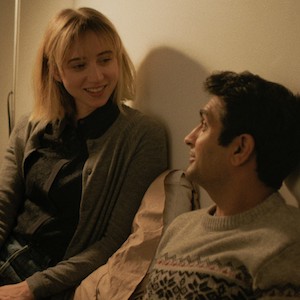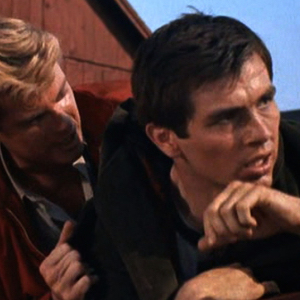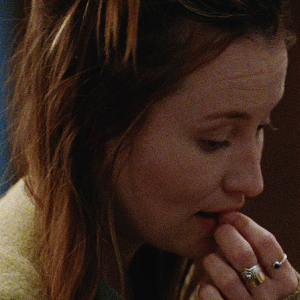The 2017 BAMcinemafest ends this Sunday, and this dispatch concludes our coverage. Among the takes below, you’ll find several more holdovers from Sundance—including hit comedy The Big Sick and Alex Ross Perry’s unfairly panned Golden Exits—and two films (a narrative and a documentary) from American indie film director Michael Almereyda. Be sure to also check out our first dispatch, which featured new films from the Amer-indie scene’s Aaron Katz, Stephen Cone, and Koganda. You can also find the remainder of the fest’s full schedule here.
The bourgeois Brooklyn of Alex Ross Perry’s Golden Exits is a “wasteland in the middle.” The film opens with an airplane flying away for somewhere else, followed by what is probably the least grooveful version of “New York Groove” that anyone has ever performed. A 25-year-old foreigner, Naomi (Emily Browning), is the one singing the very lugubrious version of that Ace Frehley anthem, and like the interstitial dates that appear onscreen throughout Perry’s film, she serves as a constant reminder of time gone by. The mere presence of Naomi taunts the various Gen X-ers that enter into and around her orbit, including two married couples — Nick (Adam Horovitz) and Alyssa (Chlöe Sevigny); Buddy (Jason Schwartzman) and Jess (Analeigh Tipton) — who begin to question their commitment to commitment, reconsidering past mistakes and present instabilities. As with his four previous films, Perry focusses on faces, and favors the intensity of the close-up. But what’s different this time is the passivity of those expressions: While Listen Up Philip and especially Queen of Earth were built around big moments of emotional upheaval, Golden Exits is all painfully unresolved repression. That tone is bolstered by an almost uncanny sense of atmosphere; the characters, in particular Sevigny’s (the secret heart of the film), fortify their anxieties with cryptic, evasive musings, while composer Keegan DeWitt’s score pirouettes ominously around them. The combined effect is something like a new form of melodrama: a film that absorbs John Cassavetes’s bracing emotional intimacy, as well as contemporary Amer-indie aesthetics, and filters these through an impressionism and an elegance (this is the first time Perry’s forgone handheld) that feels at once unfamiliar and classicist. Sam C. Mac
 The stateside media-consuming public’s seemingly insatiable appetite for standup comedy product (The Comedian, Showtime’s I’m Dying Up Here, infinite podcasts) is the target audience of The Big Sick, Kumail Nanjiani and Emily V. Gordon’s autobiographical dramatization of their own courtship. (He’s an aspiring Chicago standup, she’s a student.) Judd Apatow co-produced—the man who’s already given us Funny People and HBO’s Crashing (featuring Nanjiani’s buddy Pete Holmes). Sick earns a spot in a crowded field because, most importantly, it’s very funny. It can also be quite touching: Emily (Zoe Kazan) is stricken with an HIV-level-serious illness and put in a lengthy, medically induced coma. A great 9/11 joke encapsulates this film’s basic goal of mining trauma for laughs. But it can also border on the over-adorable at times, which is disappointing coming from director Michael Showalter, whose past works have often sought to excoriate the tropes of comedic cinema. The road-tested presence of Holly Hunter and Ray Romano as Emily’s parents save the heavier dramatic scenes, which are outside of Nanjiani’s wheelhouse. And the portrayal of Pakistani American arranged marriages is refreshingly frank and rare, showing the collateral damage of rejected potential wives and strained or severed family bonds. Justin Stewart
The stateside media-consuming public’s seemingly insatiable appetite for standup comedy product (The Comedian, Showtime’s I’m Dying Up Here, infinite podcasts) is the target audience of The Big Sick, Kumail Nanjiani and Emily V. Gordon’s autobiographical dramatization of their own courtship. (He’s an aspiring Chicago standup, she’s a student.) Judd Apatow co-produced—the man who’s already given us Funny People and HBO’s Crashing (featuring Nanjiani’s buddy Pete Holmes). Sick earns a spot in a crowded field because, most importantly, it’s very funny. It can also be quite touching: Emily (Zoe Kazan) is stricken with an HIV-level-serious illness and put in a lengthy, medically induced coma. A great 9/11 joke encapsulates this film’s basic goal of mining trauma for laughs. But it can also border on the over-adorable at times, which is disappointing coming from director Michael Showalter, whose past works have often sought to excoriate the tropes of comedic cinema. The road-tested presence of Holly Hunter and Ray Romano as Emily’s parents save the heavier dramatic scenes, which are outside of Nanjiani’s wheelhouse. And the portrayal of Pakistani American arranged marriages is refreshingly frank and rare, showing the collateral damage of rejected potential wives and strained or severed family bonds. Justin Stewart
 Admirers of David Lowery’s third feature (and second with stars Rooney Mara and Casey Affleck, after 2013’s Ain’t Them Bodies Saints) have and will point to its undeniable audacity, its commitment to a vision and its uncynical purity of emotion. They’ll appreciate cinematographer Andrew Droz Palermo’s washed-out colors, scrunched into Academy ratio compositions with rounded corners. They might also find its metaphors moving, and think it has things to say about topics both common (like grief) and metaphysical (the circular nature of history). But visionaries will always have detractors, and there’s a basic vapidity, combined with an obnoxiously hammering quality to the entire project, that will void all of those partially true kindnesses for stone-hearted doubters like this writer. [And this site’s editor –Ed.] A Ghost Story’s plot is difficult to discuss without lessening the experience for those who haven’t seen it, so I’ll leave it at Mara and Affleck’s characters being a couple living in suburban Texas (he’s a musician who serenades her with bedroom electropop) who have been hearing some night bumps in their modest home, and whose lives are gored by unexpected tragedy. As previews and posters show, there’s also a ghost, donned in standard white bed sheet with cutout eyeholes, a constant sight gag that does take some edge off of the funereal solemnity. Nietzsche, Gabriel Garcia Marquez and Virginia Woolf sleeves are pointedly lingered upon; Will Oldham stops by for a dull improv monologue; and Mara binge eats a pie for maybe five minutes that feels like 20—the sort of insufferable artistic gamble with which the film’s littered, and which render questionable even the first half of the expression “interesting failure.” JS
Admirers of David Lowery’s third feature (and second with stars Rooney Mara and Casey Affleck, after 2013’s Ain’t Them Bodies Saints) have and will point to its undeniable audacity, its commitment to a vision and its uncynical purity of emotion. They’ll appreciate cinematographer Andrew Droz Palermo’s washed-out colors, scrunched into Academy ratio compositions with rounded corners. They might also find its metaphors moving, and think it has things to say about topics both common (like grief) and metaphysical (the circular nature of history). But visionaries will always have detractors, and there’s a basic vapidity, combined with an obnoxiously hammering quality to the entire project, that will void all of those partially true kindnesses for stone-hearted doubters like this writer. [And this site’s editor –Ed.] A Ghost Story’s plot is difficult to discuss without lessening the experience for those who haven’t seen it, so I’ll leave it at Mara and Affleck’s characters being a couple living in suburban Texas (he’s a musician who serenades her with bedroom electropop) who have been hearing some night bumps in their modest home, and whose lives are gored by unexpected tragedy. As previews and posters show, there’s also a ghost, donned in standard white bed sheet with cutout eyeholes, a constant sight gag that does take some edge off of the funereal solemnity. Nietzsche, Gabriel Garcia Marquez and Virginia Woolf sleeves are pointedly lingered upon; Will Oldham stops by for a dull improv monologue; and Mara binge eats a pie for maybe five minutes that feels like 20—the sort of insufferable artistic gamble with which the film’s littered, and which render questionable even the first half of the expression “interesting failure.” JS
 Sometime in the near future, Tess (Geena Davis) and her husband Jon (Tim Robbins) gift octogenarian widow Marjorie (Lois Smith) an A.I. hologram version of her dead husband, to keep her talking and to fortify her faltering, faulty memory. Marjorie went with the age 40-ish version, who looks like Jon Hamm, but the reasons weren’t entirely cosmetic. The science-fiction premise of both this and the Jordan Harrison play on which it’s based is a departure point for many slow-burn profundities about family dynamics, mortality and, especially, memory, given credence and weight by the four uniformly superb lead performances. As in the memory plays of Harold Pinter, ever-malleable memory itself becomes weaponized, though Marjorie Prime never becomes sinister or nasty like other recent sci fi-informed films (Ex Machina or Under the Skin). Which isn’t to say it’s at all comfy; its numerous brain-bending twists are disturbing, and at one point Robbins’s Jon throws a glass of whisky into the hologram’s face. (It only splashes the wall behind him, of course.) The always-interesting and restless Michael Almereyda—whose Experimenter also explored fallible human psychology—blocks and breaks up the action cleanly, and Sean Price Williams’s pristine cinematography prevents this remarkable film from ever feeling stagey or theatrical. JS
Sometime in the near future, Tess (Geena Davis) and her husband Jon (Tim Robbins) gift octogenarian widow Marjorie (Lois Smith) an A.I. hologram version of her dead husband, to keep her talking and to fortify her faltering, faulty memory. Marjorie went with the age 40-ish version, who looks like Jon Hamm, but the reasons weren’t entirely cosmetic. The science-fiction premise of both this and the Jordan Harrison play on which it’s based is a departure point for many slow-burn profundities about family dynamics, mortality and, especially, memory, given credence and weight by the four uniformly superb lead performances. As in the memory plays of Harold Pinter, ever-malleable memory itself becomes weaponized, though Marjorie Prime never becomes sinister or nasty like other recent sci fi-informed films (Ex Machina or Under the Skin). Which isn’t to say it’s at all comfy; its numerous brain-bending twists are disturbing, and at one point Robbins’s Jon throws a glass of whisky into the hologram’s face. (It only splashes the wall behind him, of course.) The always-interesting and restless Michael Almereyda—whose Experimenter also explored fallible human psychology—blocks and breaks up the action cleanly, and Sean Price Williams’s pristine cinematography prevents this remarkable film from ever feeling stagey or theatrical. JS
 Most documentaries live and die by how much they can ‘get out of’ their subjects, which makes Escapes seem relatively low-stakes at first. In chronicling the life of Hampton Fancher—a D-list western actor turned screenwriter, who happened to write the Blade Runner script—director Michael Almereyda molds a seemingly mundane narrative into a meditation on the ability to transform oneself. Using decades-old archival footage of Hampton on shows like Have Gun – Will Travel, Almereyda’s subject becomes the characters that the audience sees on screen. He’s a gunslinging cowboy when he tries to rough somebody up for not paying rent money to his then-girlfriend, Sue Lyon; then he becomes Humbert Humbert (where Lyon appears playing the titular Lolita), when the film points out they began seeing each other when she was 17. It’s almost an hour into the film before any mention of Fancher’s treatment of Philip K. Dick’s Do Androids Dream of Electric Sheep comes to light, but by then it feels like an afterthought. It’s also the single weakest section of the film, simply because of the lack of footage that remains of Fancher by this point. The effect Almereyda’s going for works when he can mold his subject into the people he plays on screen, giving this forgotten man the freedom to be who he wants to be. Paul Attard
Most documentaries live and die by how much they can ‘get out of’ their subjects, which makes Escapes seem relatively low-stakes at first. In chronicling the life of Hampton Fancher—a D-list western actor turned screenwriter, who happened to write the Blade Runner script—director Michael Almereyda molds a seemingly mundane narrative into a meditation on the ability to transform oneself. Using decades-old archival footage of Hampton on shows like Have Gun – Will Travel, Almereyda’s subject becomes the characters that the audience sees on screen. He’s a gunslinging cowboy when he tries to rough somebody up for not paying rent money to his then-girlfriend, Sue Lyon; then he becomes Humbert Humbert (where Lyon appears playing the titular Lolita), when the film points out they began seeing each other when she was 17. It’s almost an hour into the film before any mention of Fancher’s treatment of Philip K. Dick’s Do Androids Dream of Electric Sheep comes to light, but by then it feels like an afterthought. It’s also the single weakest section of the film, simply because of the lack of footage that remains of Fancher by this point. The effect Almereyda’s going for works when he can mold his subject into the people he plays on screen, giving this forgotten man the freedom to be who he wants to be. Paul Attard
 Following a woman on the Autism spectrum before her second marriage, Dina feels like a documentary that could have been rife with exploitation, and in lesser hands it might be. But directors Antonio Santini and Dan Sickles don’t approach their subject (full name Dina Bruno) as the “other” or “special”; they simply allow her to exist in a way that never feels demeaning or that revolves strictly around her disorder, but rather defines her as a fiercely opinionated and loving woman. The duo’s film also allows itself to be consistently funny, without the laughs ever coming at Dina’s expense. (When Dina tries to talk to her partner about sex, the source of the scene’s humor isn’t ‘two people with Aspergers talking about S&M,’ but the more general frankness of the couple’s discussion.) The film’s rare sense of honesty and sincerity is only compromised towards the end, by a revelation about Dina’s past marriage which feels opportunistic at worst and somewhat tone-deaf at best. The scene registers as contrary to the goodwill Santini and Sickles had been building up to this point, but the misstep is instructive: Dina demonstrates both a positive way to make a film about mental handicaps, and how easily those intentions can go awry. PA
Following a woman on the Autism spectrum before her second marriage, Dina feels like a documentary that could have been rife with exploitation, and in lesser hands it might be. But directors Antonio Santini and Dan Sickles don’t approach their subject (full name Dina Bruno) as the “other” or “special”; they simply allow her to exist in a way that never feels demeaning or that revolves strictly around her disorder, but rather defines her as a fiercely opinionated and loving woman. The duo’s film also allows itself to be consistently funny, without the laughs ever coming at Dina’s expense. (When Dina tries to talk to her partner about sex, the source of the scene’s humor isn’t ‘two people with Aspergers talking about S&M,’ but the more general frankness of the couple’s discussion.) The film’s rare sense of honesty and sincerity is only compromised towards the end, by a revelation about Dina’s past marriage which feels opportunistic at worst and somewhat tone-deaf at best. The scene registers as contrary to the goodwill Santini and Sickles had been building up to this point, but the misstep is instructive: Dina demonstrates both a positive way to make a film about mental handicaps, and how easily those intentions can go awry. PA



Comments are closed.